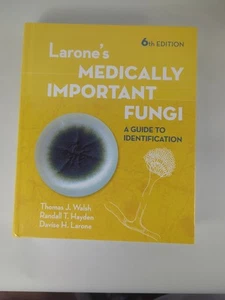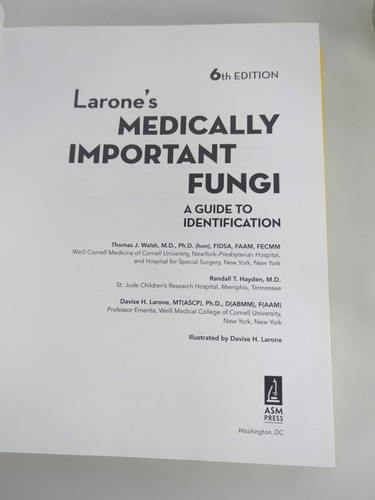Bild 1 von 5





Galerie
Bild 1 von 5





Larones medizinisch wichtige Pilze: - Hardcover, von Walsh Thomas J. - sehr gut-
US $39,90
Ca.EUR 35,16
Artikelzustand:
Sehr gut
Buch, das nicht neu aussieht und gelesen wurde, sich aber in einem hervorragenden Zustand befindet. Der Einband weist keine offensichtlichen Beschädigungen auf. Bei gebundenen Büchern ist der Schutzumschlag vorhanden (sofern zutreffend). Alle Seiten sind vollständig vorhanden, es gibt keine zerknitterten oder eingerissenen Seiten und im Text oder im Randbereich wurden keine Unterstreichungen, Markierungen oder Notizen vorgenommen. Der Inneneinband kann minimale Gebrauchsspuren aufweisen. Minimale Gebrauchsspuren. Genauere Einzelheiten sowie eine Beschreibung eventueller Mängel entnehmen Sie bitte dem Angebot des Verkäufers.
Oops! Looks like we're having trouble connecting to our server.
Refresh your browser window to try again.
Versand:
US $6,13 (ca. EUR 5,40) USPS Media MailTM.
Standort: Warner Robins, Georgia, USA
Lieferung:
Lieferung zwischen Mi, 4. Jun und Mo, 9. Jun bei heutigem Zahlungseingang
Rücknahme:
30 Tage Rückgabe. Verkäufer zahlt Rückversand.
Zahlungen:
Sicher einkaufen
Der Verkäufer ist für dieses Angebot verantwortlich.
eBay-Artikelnr.:306224747191
Artikelmerkmale
- Artikelzustand
- Book Title
- Larone's Medically Important Fungi: A Guide to Identification
- ISBN
- 9781555819873
Über dieses Produkt
Product Identifiers
Publisher
ASM Press
ISBN-10
1555819877
ISBN-13
9781555819873
eBay Product ID (ePID)
5038510756
Product Key Features
Number of Pages
550 Pages
Publication Name
Larone's Medically Important Fungi : a Guide to Identification
Language
English
Publication Year
2018
Subject
Clinical Medicine, Microbiology
Type
Textbook
Subject Area
Medical
Series
Asm Bks.
Format
Hardcover
Dimensions
Item Height
1.2 in
Item Weight
46.5 Oz
Item Length
9.2 in
Item Width
7.6 in
Additional Product Features
Edition Number
6
Intended Audience
Scholarly & Professional
LCCN
2018-015129
Reviews
"This new edition excels in its depth of information, ease of use and degree of utility to the clinical mycologist/microbiologist. It is our "go-to" reference for learning clinical mycology and arbitrating challenging identifications."Kevin C. Hazen, Ph.D., D(ABMM), FAAM, FIDSA, This well-established manual has really withstood the test of time, evolving through the last four decades. It first came out in 1976, and the edition prior to this one was published by the American Society of Microbiology in 2011. This record demonstrates that it fulfills a real need amongst medical mycologists; indeed, it is referred to in the Preface as an "esteemed, beloved, and time-honored book" (p. xvii). This is perhaps in no small measure because the authors are all hospital or medical college based and at the sharp end of diagnosis of conditions due to fungi. They take a pragmatic approach and have endeavored to provide a manual that provides as much as possible to make this a one-stop-shop for clinicians and laboratory technicians -- taking them as far as they can and then with information on how to proceed with "rare or atypical fungi". Indeed, guidance on the use of reference laboratories and how to safely package and transport material appears right at the start of the book, followed by sections of safety procedures to be followed and taxonomy and nomenclature. I was pleased to see the issue of the need to be aware of cryptic species being flagged up, and that the one-name-one-fungus decision had been embraced, albeit with the common misunderstanding that this was effective from January 2013 rather than the actual date of July 2011... While the book does perhaps have something of a North American slant, for example not including species such as Neotestudina rosatii, it is by far the best book on clinical mycology I am aware of tailored for the hospital laboratory, providing a bridge between more superficial texts and the monographic approach of the Atlas of Clinical Fungi...Davise Larone should be very pleased to see the work she started so long ago going from strength to strength, and continuing to fulfill a real need, as she commences her 80th year. -David Hawksworth , excerpted from the full review in IMA Fungus Vol. 9, No. 2, Book News " REVIEW 2 Recognizing the increase in fungal infections of humans and the decrease of formal training in mycology for clinical laboratory personnel, the bench-side guide and teaching aid describes the macroscopic and microscopic morphologies of cultured fungi as pertaining to those on Sabouraud dextrose agar. Black and white images depict different types of filamentous bacteria, yeasts, thermally dimorphic fungi, and thermally monomorphic molds. A section on laboratory technique details lab procedures, staining methods, and media preparation. The sixth edition adds an essay on taxonomy and nomenclature, identifies emerging pathogens, and updates technological advances in next-generation sequencing, real-time PCR, melt curve analysis, and T2 magnetic resonance. -PROTOVIEW (NO INDIVIDUAL REVIEWER NOTED), This new edition excels in its depth of information, ease of use and degree of utility to the clinical mycologist/microbiologist. It is our go-toreference for learning clinical mycology and arbitrating challenging identifications.Kevin C. Hazen, Ph.D., D(ABMM), FAAM, FIDSA
Number of Volumes
1 vol.
Illustrated
Yes
Synopsis
The definitive guide for identifying fungi from clinical specimens Medically Important Fungi will expand your knowledge and support your work by: Providing detailed descriptions of the major mycoses as viewed in patients' specimens by direct microscopic examination of stained slides Offering a logical step-by-step process for identification of cultured organisms, utilizing detailed descriptions, images, pointers on organisms' similarities and distinctions, and selected references for further information Covering nearly 150 of the fungi most commonly encountered in the clinical mycology laboratory Presenting details on each organism's pathogenicity, growth characteristics, relevant biochemical reactions, and microscopic morphology, illustrated with photomicrographs, Dr. Larone's unique and elegant drawings, and color photos of colony morphology and various test results Explaining the current changes in fungal taxonomy and nomenclature that are due to information acquired through molecular taxonomic studies of evolutionary fungal relationships Providing basic information on molecular diagnostic methods, e.g., PCR amplification, nucleic acid sequencing, MALDI-TOF mass spectrometry, and other commercial platforms Including an extensive section of easy-to-follow lab protocols, a comprehensive list of media and stain procedures, guidance on collection and preparation of patient specimens, and an illustrated glossary With Larone's Medically Important Fungi: A Guide to Identification , both novices and experienced professionals in clinical microbiology laboratories can continue to confidently identify commonly encountered fungi., The definitive guide for identifying fungi from clinical specimens Medically Important Fungi will expand your knowledge and support your work by: Providing detailed descriptions of the major mycoses as viewed in patients' specimens by direct microscopic examination of stained slides Offering a logical step-by-step process for identification of cultured organisms, utilizing detailed descriptions, images, pointers on organisms' similarities and distinctions, and selected references for further information Covering nearly 150 of the fungi most commonly encountered in the clinical mycology laboratory Presenting details on each organism's pathogenicity, growth characteristics, relevant biochemical reactions, and microscopic morphology, illustrated with photomicrographs, Dr. Larone's unique and elegant drawings, and color photos of colony morphology and various test results Explaining the current changes in fungal taxonomy and nomenclature that are due to information acquired through molecular taxonomic studies of evolutionary fungal relationships Providing basic information on molecular diagnostic methods, e.g., PCR amplification, nucleic acid sequencing, MALDI-TOF mass spectrometry, and other commercial platforms Including an extensive section of easy-to-follow lab protocols, a comprehensive list of media and stain procedures, guidance on collection and preparation of patient specimens, and an illustrated glossary With Larone's Medically Important Fungi: A Guide to Identification , both novices and experienced professionals in clinical microbiology laboratories can continue to confidently identify commonly encountered fungi. If you are looking for online access to the latest clinical microbiology content, please visit www.wiley.com/learn/clinmicronow.
LC Classification Number
QR245.L37 2018
Artikelbeschreibung des Verkäufers
Info zu diesem Verkäufer
mrajen03
100% positive Bewertungen•23 Tsd. Artikel verkauft
Angemeldet als privater VerkäuferDaher finden verbraucherschützende Vorschriften, die sich aus dem EU-Verbraucherrecht ergeben, keine Anwendung. Der eBay-Käuferschutz gilt dennoch für die meisten Käufe.
Verkäuferbewertungen (10.047)
- b***9 (4757)- Bewertung vom Käufer.Letzter MonatBestätigter KaufVery good! Thanks!
- s***1 (217)- Bewertung vom Käufer.Letzter MonatBestätigter KaufAs described. Quick shipping. Good seller.
- m***i (875)- Bewertung vom Käufer.Letzter MonatBestätigter KaufAs described, thank you!
Noch mehr entdecken:
- Thomas Jefferson Belletristik-Bücher,
- Thomas Hardy Belletristik-Bücher,
- Bücher von Thomas Brezina für junge Leser,
- Thomas Fischer Studium und Erwachsenenbildung,
- Thomas-Jefferson-Sachbuch Bücher,
- Thomas -/- Putzo-Rechtswissenschaften Bücher für Studium & Erwachsenenbildung,
- Bücher von Thomas Brezina Jugendliche Belletristik auf Deutsch,
- Thomas Brezina Bücher mit Kinder- & Jugendliteratur-Genre,
- Thomas Brezina Bücher mit Kinder- & Jugendliteratur Jugendliche,
- Thomas Brezina Romane & Erzählungen für Kinder & Jugendliche